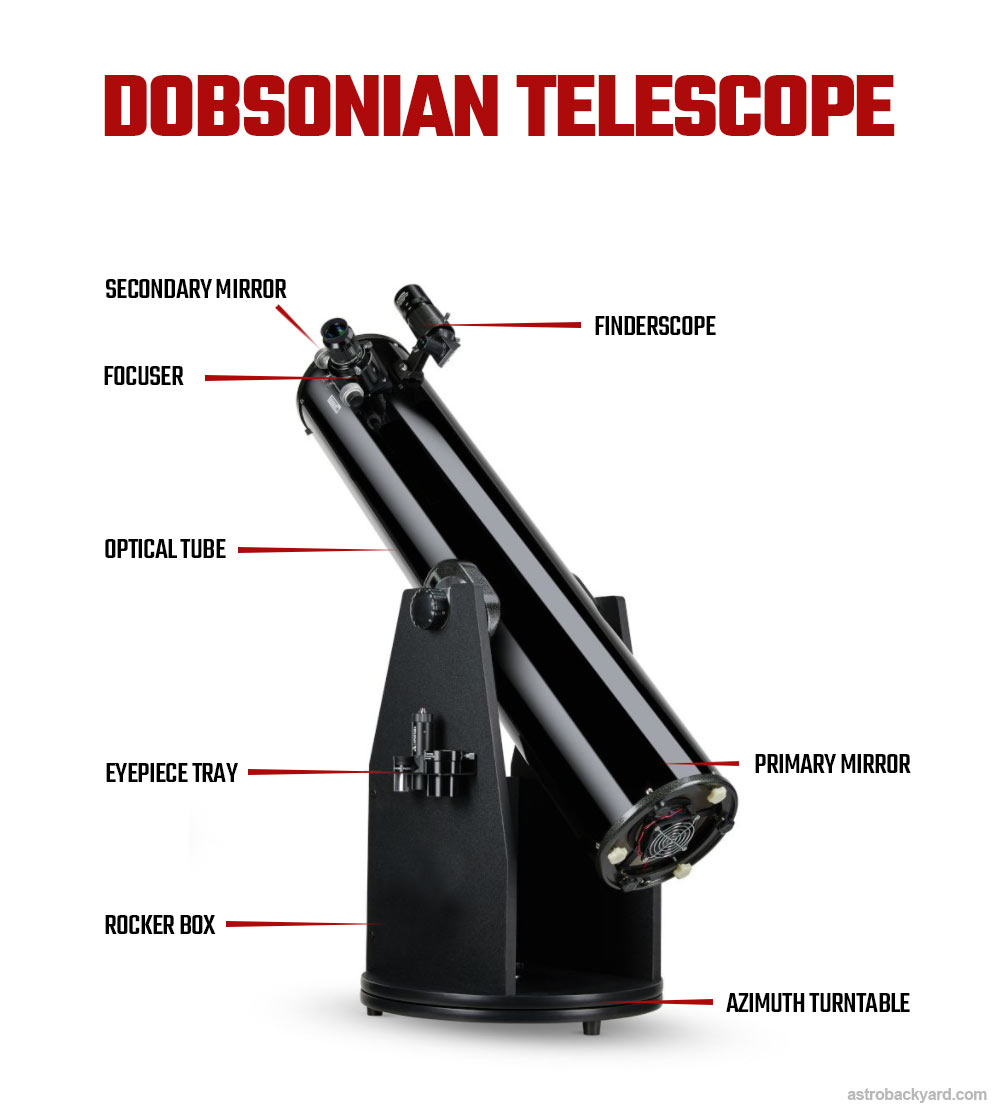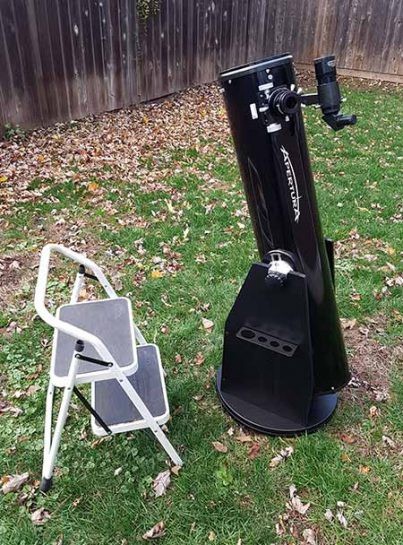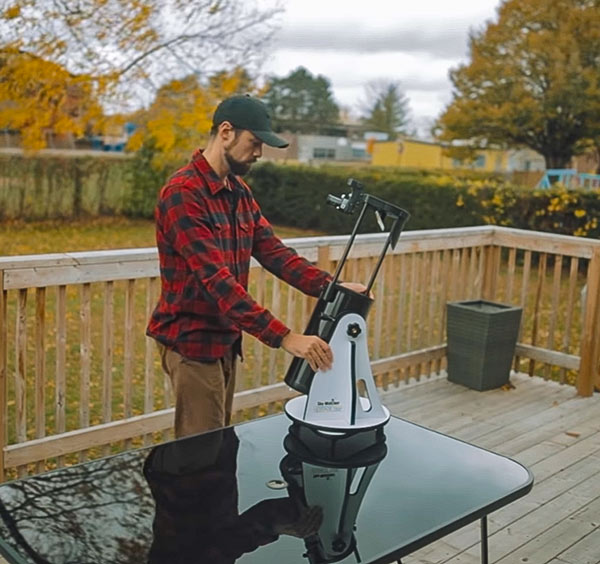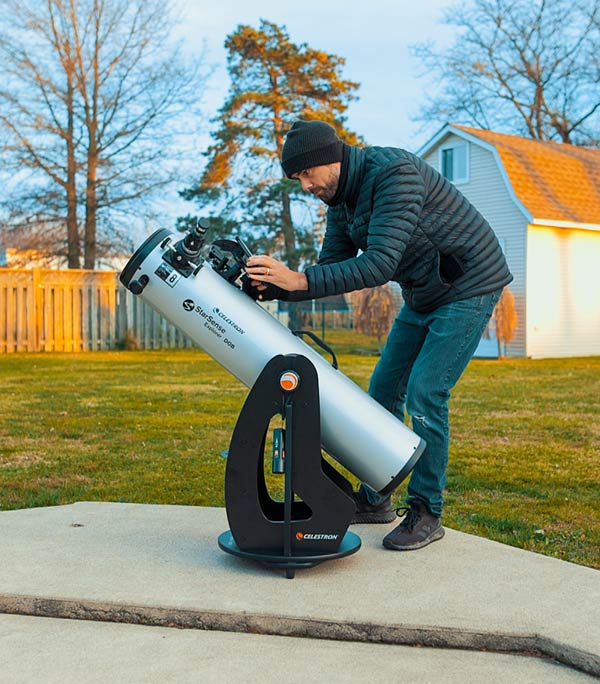The Dobsonian Telescope
A Dobsonian telescope is widely agreed to be the best possible “first telescope” for a beginner. It offers the largest aperture for the price, delivering impressive visual views through the eyepiece.
A Dobsonian (or “Dob”) is a type of telescope that was popularized by John Dobson in 1965. The simple altazimuth-mounted Newtonian reflector design is perfect for amateur astronomers as it offers impressive light-gathering power at an affordable price.
The telescope works by reflecting the light that enters the optical tube assembly from a curved primary mirror to a flat secondary mirror. The secondary mirror directs the light to the focuser and your telescope eyepiece.
Using a GoTo Dobsonian Telescope in my backyard. (Sky-Watcher FlexTube 350P)
Thanks to a large objective diameter, the Dobsonian design is perfect for observing faint, deep-sky objects such as nebulae and galaxies. This telescope type is a popular choice at star parties and visual observations from a dark sky site.
In fact, in the summer of 2023, I brought the biggest telescope I’ve ever used to a star party, and it was a 14″ collapsable Dobsonian telescope (Sky-Watcher FlexTube 350P).
You do not need a huge Dobsonian telescope for incredible views of space, an 8″ model is more than enough to see most of the best objects in the night sky.
The altazimuth base of a Dobsonian requires you to manually point the telescope in the direction of your subject by pushing the azimuth turntable. Then, you can point the telescope up or down (altitude) by manually moving the optical tube within the rocker box.
When your celestial subject is in the field of view of the eyepiece, you can tighten the control knobs to stiffen the movements of the telescope. A well-balanced optical tube inside of the rocker box is essential for an enjoyable experience.
Dobsonians are often referred to as “light buckets” because they offer the widest aperture for the price. They use mirrors instead of glass (like a refractor telescope does).
Generally, the larger the aperture, the more light the telescope can collect. The added aperture helps to reveal a brighter and more detailed image of your subject than you would see with a smaller telescope.
I currently own and enjoy an Apertura AD8 Dobsonian (best value) telescope, and the Celestron StarSense Explorer Dob (includes smartphone app) for visual observing of the night sky in my backyard.
My current Dobsonian Telescope.
The “light bucket” design is optimized for low magnification observing, without the aid of equatorial tracking. The movement of the telescope is completely manual, providing a fluid, exploration-style experience.
Dobsonian telescopes with tracking capabilities are available, but the price and complexity of the design increase with this feature.
To get the most out of your Dobsonian telescope, be sure to use a stargazing app on your smartphone to help you locate objects and help you learn more about the objects you are looking at.
My First Telescope was a Dobsonian
My first telescope was a small Dobsonian, with a modest aperture of 4.5″. This telescope showed me the planet Saturn, the Andromeda Galaxy, and the Orion Nebula for the first time.
Most of my observing with this telescope was done in the backyard, but I also brought it on several camping trips to dark-sky locations.
As with any telescope, the detail and quality of the image through the eyepiece improve when you get as far away from city light pollution as possible.
My first telescope was a portable Dobsonian. (Orion SkyQuest 4.5).
I highly recommend the Dobsonian Telescope for beginners, because they are one of the best ways to experience a positive first night of stargazing. The uncomplicated, approachable design and manual experience create a deeper connection with the night sky.
Tabletop Newtonian reflectors are essentially mini Dobsonians and are a great way to explore the night sky from home. Below, you can see me setting up a portable tabletop Dobsonian telescope using the same design concepts as a larger version, in a compact size.
You notice that this version includes a collapsible truss-tube design that helps keep the weight and profile of the telescope to a minimum.
Advantages of a Dobsonian Telescope
- Large aperture for the price (affordable)
- Portable and easy to use (up to 8″ in aperture)
- Impressive views of nebulae, galaxies, star clusters, and planets
Disadvantages of a Dobsonian Telescope
- Not meant for astrophotography
- Larger Dobs can be heavy and difficult to travel with
- Require regular collimation for best results
Like many other aspects of astronomy and/or astrophotography, you need to take advice and recommendations with a grain of salt. For example, although a Dobsonian was meant for astrophotography, it doesn’t mean that you can’t try.
Beginners looking to take pictures through their telescope (even without a star tracker or equatorial telescope mount) can place their camera or smartphone up to the eyepiece and give it a shot.
The following images of planets were captured by me, using a point-and-shoot camera similar in capabilities to a modern smartphone.
Solar system objects captured using a point-and-shoot camera and Dobsonian telescope.
If you are looking to photograph planets yourself, be sure to read my article on attaching a camera to your telescope. This can be a fun way to show your friends the close-up views of the moon or planets through your Dobsonian.
When you are ready to advance your solar system imaging skills, you can look into a tracking telescope mount with a dedicated astronomy camera to photograph planets like Jupiter in detail.
Collimation
The Newtonian reflector design requires regular collimation for optimal performance. Beginners may find this task a bit daunting at first, but there are many useful guides available online to help you.
The process of collimating a reflector telescope involves aligning the primary and secondary mirrors with each other. This can be done using simple tools such as a laser collimator to assist in the process.
Collimation diagram (Sky and Telescope).
Your Dobsonian telescope will likely include detailed instructions about how to collimate the telescope for optimal performance.
If not, here are step-by-step tips you can use to collimate your Newtonian Reflector Dobsonian telescope yourself.
How to Collimate a Newtonian Telescope:
- Set up the telescope: Set up your Dobsonian reflector telescope in a stable position during the day, and point it toward the sky (well away from the Sun). Tighten the tension knobs (if possible) to avoid any movement during collimation.
- Remove the eyepiece: Take out the eyepiece from the telescope’s focuser, and replace it will the collimation cap that came with your telescope. It will look like a lens cap with a pin hole in the middle.
- Adjust the secondary mirror: To collimate the secondary mirror, place the collimation cap in the focuser. Adjust the secondary mirror’s tilt at the back of the telescope so the reflection is centered with the hole in the collimation cap.
- Align the primary mirror: Newtonian telescopes have three collimation screws on the back of the primary mirror cell. Make small adjustments to these screws until the dot in the center of the primary mirror is aligned with your view through the collimation cap, and the secondary mirror.
- Verify the collimation: This part needs to be done at night. Choose a high-power eyepiece and focus on a star field in the sky. Observe the stars, and look for sharpness and clarity across the entire field of view. You can also focus in and out and check the shape of the stars when they are out of focus. They should look like perfectly round ‘doughnuts’.
To make this process easier I suggest using a laser collimator. This will make it easier to confirm the alignment of your primary mirror and should result in better collimation overall.
A Red Laser Collimator for Newtonian Telescopes.
Dobsonian Telescope Astrophotography Tips
While a Dobsonian telescope was originally intended to be used for astrophotography, many amateur astrophotographers are attempting this feat and achieving incredible results.
The main reason a Dobsonian telescope isn’t technically meant for astrophotography is that it uses an Alt-Az (altitude and azimuth) mount, which doesn’t match the smooth rotation of the night sky the way an equatorial mount does.
However, modern astrophotography cameras are able to collect impressive images in a very short amount of time, allowing you to photograph planets, the moon, stars, and even the brightest deep-sky objects.
In the following video, I capture images of the planets, moon, and even a bright nebula using a Dobsonian telescope:
Here are some simple, practical tips I have put together for anyone looking to do astrophotography with a Dobsonian telescope.
- Stick to solar system objects because they are very bright compared to deep-sky objects
- Secure your camera to the focuser using the appropriate adapter for your specific camera (smartphone holder, DSLR t-ring, etc.)
- Use a delay timer on your camera to take a steady shot. Any slight movements will ruin the image
- Use a planetary astronomy camera for the best results. These cameras are more sensitive and will be easier to attach to the telescope
- Record a video of the object, and use astrophotography software like AutoStakkert to extract and stack the best frames.
Many people start by taking images of the moon and brightest planets using their smartphone at the eyepiece.
While it is possible to take a decent photo using this method, it can be very difficult (and frustrating) to align the camera lens on your phone with the center of the eyepiece.
It is always better to fasten the camera directly to the telescope focuser to center the eyepiece and/or directly align the camera sensor with the focus point of the secondary mirror.
Storing and Cleaning Your Dobsonian Telescope
A good storage place that is dust-free and secure will help you ensure that your Dobsonian telescope lasts a lifetime. A storage location that is easy to move the telescope in and outside without a lot of work is recommended (such as an insulated garage).
If your garage becomes very hot or very cold in the summer and winter seasons, it is better to bring your Dobsonian telescope indoors. If you plan on keeping the telescope in your basement, make sure that the air is dry, and use a dehumidifier if necessary.
You will always want to cover the optics of the telescope when it is not in use. Use the dust cap that came with your telescope to cover the objective, and keep a cap on the focuser tube as well.
Although all mirrors will collect dust on the surface over time, this does not affect the optical performance of the telescope as much as you may think. A little bit of dust is okay.
You do not want to use a harsh cleaning solution to clean the mirror of your telescope, a little dish soap and distilled water is all you need.
However, if the mirrors are so dusty that they are affecting image quality, you can watch the following video to better understand the cleaning process.
Finding Deep-Sky Objects with a Dobsonian Telescope
The brightest objects in the night sky like planets and the moon are easy to find with your telescope.
Thanks to the user-friendly design of the Dobsonian base, you can simply point the finder scope of your telescope to a solar system object, and it will appear in the eyepiece for you to enjoy.
But what about the more faint, distant objects in the night sky such as galaxies, star clusters, and nebulae? These objects will be a little harder to locate manually, but well worth the effort.
First off, I suggest choosing one of the brightest nebulae in the sky, to make the process easier and rewarding. Certain galaxies and nebulae have a higher surface brightness and will be easier to spot.
Secondly, use a star chart or mobile star map on your smartphone to help guide you in the right direction. My personal favorite stargazing app is Stellarium, but there are many great options to choose from.
Learn how to ‘star-hop’ from a familiar constellation and or bright star, and slowly move the direction of the telescope toward the area of the sky where the deep-sky object lies.
Use a low-powered, wide-angle eyepiece to start with, as this will make it easier to maintain your position in the sky without getting ‘lost in space’.
Once you have identified the object or at least the general area, you can switch to a more high-powered eyepiece for a closer look.
Looking for deep-sky objects with my Dobsonian telescope in the backyard.
If you aren’t interested in manually finding deep-sky objects with your Dobsonian telescope (you’d be surprised at how fun this can be), you have some other options.
One is to use a telescope like the Celestron StarSense Explorer 8, which includes a smartphone mount and a dedicated app to guide your position in the night sky.
Another option is to choose a Dobsonian telescope with a computerized GoTo system, that can automatically slew to any object in the night sky for you.
I had the pleasure of testing a Sky-Watcher FlexTube 350P with this feature in 2023, and it worked incredibly well. To see a telescope of this size slew to an object is quite the spectacle.
The Sky-Watcher 14″ FlexTube SynScan 350P GoTo Dobsonian Telescope.
Looking Through a 20-inch Dobsonian Telescope
During the summer of 2016, I was fortunate enough to explore the night sky through a 20-inch Dobsonian telescope from a dark sky site (Bortle 4). This telescope was so big, I had to climb a ladder to look through it.
A photo of me looking through a 20″ Dobsonian Telescope.
A member of my Local Astronomy Club in Niagara (RASC – Niagara Centre) owns a massive 20 Inch Dobsonian Telescope that he will often bring out to our Observatory Site in the summer. This experience is always a real treat, as the views through this giant “Dob” are incredible.
This telescope is so huge, that you must climb a ladder to look through the eyepiece when it is pointing at most targets overhead! The best views I have had through this 20″ Obsession Dobsonian are of the planet Saturn and the Messier 3 Globular Cluster.
It’s impossible to show you exactly what the view was like, but this photo of Messier 3 I captured gives you a rough idea. The truth is, it’s impossible to capture the beauty of the intensely dense group of stars of Messier 3 in a photo. The real-time view is much better.
The M3 Globular Cluster
With so much aperture, the deep-sky objects that are usually dim and hard to find with an average-sized telescope are bright and detailed.
The massive mirror in this Dob allows much more light to be reflected into the eyepiece than a typical telescope. If you can handle all of the extra weight and transportation requirements, a giant 20″ Inch Dobsonian will offer you views of Nebulae, Galaxies, and Star Clusters like you have never seen before.
36″ Dobsonian
In the summer of 2018, I had the privilege of looking through a 36″ Dobsonian Reflector telescope, at the Cherry Springs Star Party. The combination of a 3-foot primary mirror and the dark skies of Cherry Springs State Park made for a sensational observing session.
Large Dobsonian telescopes are common at star parties, and many of them were custom-built by their owners. If you are looking to build your own Dobsonian telescope, the following guide should put you on the right path.
Build Your Own Dobsonian Telescope (Stellafane)
Recommended Dobsonian Telescopes
If you’re not up to the challenge of maintaining and storing a large Dob, consider a smaller variation that will likely get more use. A 20-36″ primary mirror will sure pull in more “faint fuzzies”, but it’s not a practical solution for the average observer.
If memorable views of the night sky are on your agenda, I suggest taking a good look at the Apertura AD8 Dobsonian Telescope. If you need a little help finding objects in the eyepiece, consider the Celestron StarSense Explorer Dob with an integrated smartphone dock and mobile app.
An 8-inch mirror is enough to reveal some of the fainter deep sky targets, yet the telescope is manageable enough to get a lot of use. This model comes with an impressive number of accessories including 2 eyepieces (I especially like the 2″ 30mm Plossl eyepiece) and a laser collimation tool.
The Celestron StarSense Explorer Dob
The biggest Dobsonian telescope I have ever used was a 14″ Sky-Watcher FlexTube 350P. While this telescope offers incredible views and can find objects in space for you, it is likely too heavy for the casual observer.
An 8-inch telescope is the ‘sweet spot’ between exceptional views through the eyepiece, and a size that is manageable for most people. A telescope that is easy to use will get used a lot more often.
The Best Dobsonian Telescope
Here is a list of telescopes I have used personally with great success. Each of them has a specific advantage that you may want to consider when purchasing your first Dobsonian telescope.
It is wise to think of your desired user experience before investing in a telescope, so you can enjoy it for years to come.
The Apertura AD8 offers the best value and provides a large, 8-inch aperture at an affordable price. It includes all of the accessories needed to start exploring the night sky and finding objects yourself.
The Celestron StarSense Explorer 8 also features an 8-inch aperture, but it also includes the StarSense smartphone dock and a dedicated app to help you find objects in the night sky. This is a better object if you want some help locating dim, deep-sky objects.
Lastly, the Sky-Watcher Virtuosa GTi 150P gives you complete computerized GoTo functionality on a reasonable-sized ‘Dob. This model is the smallest of the group at 6 inches, but it still gathers plenty of light to see some of the best objects in space.
Choosing an Eyepiece for Your Telescope
Once you’ve got a quality optical instrument to observe the night sky with, you may want to invest in some premium eyepieces to enhance the experience. There are some incredible options out there, but my favorite type of eyepiece is one that delivers a wide field of view, such as the Explore Scientific 14mm 100 model below.
Keep in mind that you may experience balance issues with your Dobsonian telescope with a heavy eyepiece in place. Models that include lock knobs on the rocker box will help ensure that the telescope does not move on its own due to uneven balance.
Recommended Eyepieces at High Point Scientific














